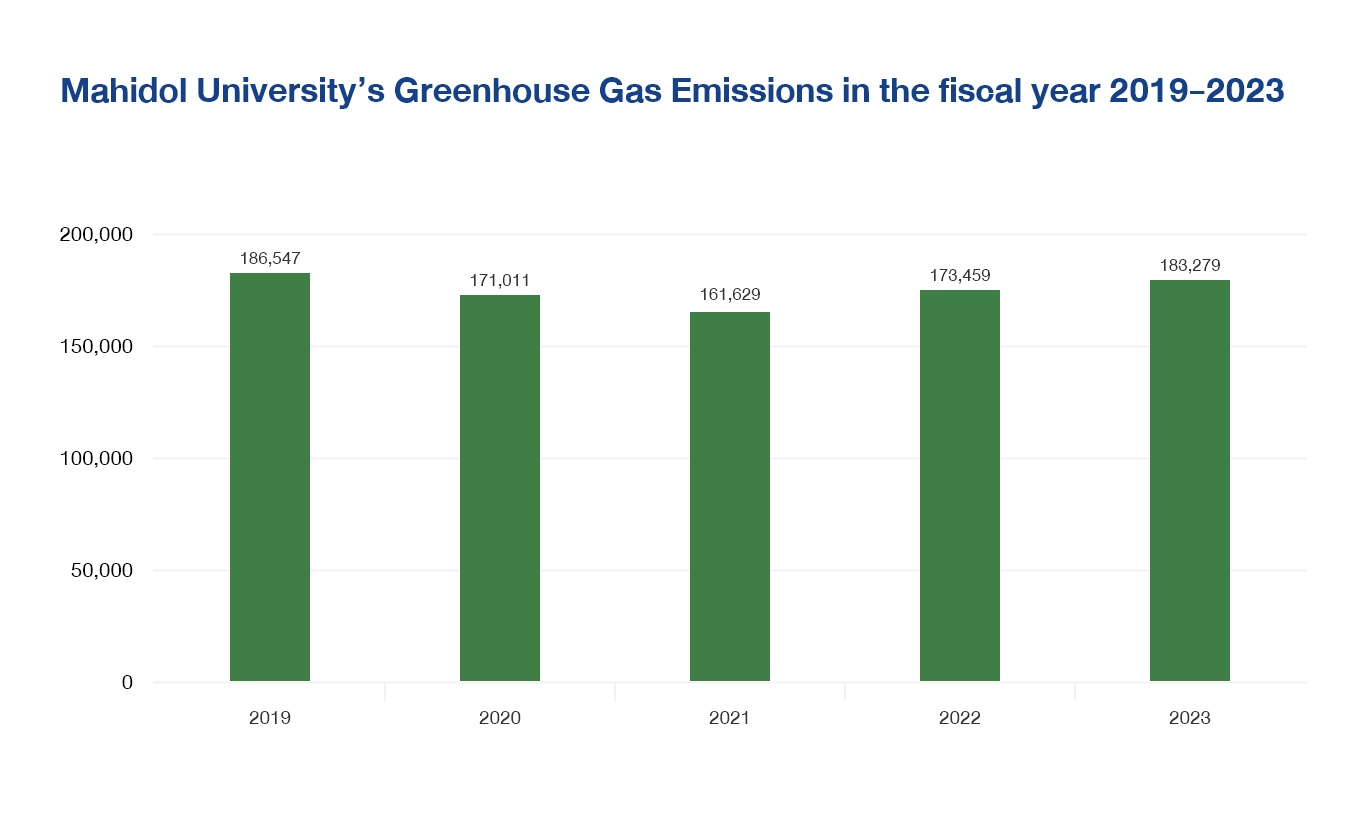Net Zero Emission
Effects of climate change, continuous and increasing greenhouse gases emission, and global warming. Without an immediate action, irreversible results could occur, whether economical loss or impact on lives and properties resulting from climate change.
From the agreement from the 24th session of Convention of the Parties (COP24) regarding climate change (United Nations Framework Convention on Climate Change: UNFCC), aiming to have net zero emission of greenhouse gases by 2050 in order to keep the global temperature not to increase above 1.5 degree Celsius, the key goals and purposes of the convention are controlling the amount greenhouse gases emission, the cause of global warming and climate change, and preventing global temperature not to raise above 2 degree Celsius, which would be the irreversible level and harmful for humanity.

Mahidol University realizes the importance and urgency of climate change that affects the environment and human beings. This Net Zero Emission Policy is set to be a part of the climate change effects reduction, and to drive the sustainable development goal SDG 13: Climate Action – Urgent operation to handle climate change and its effects by gathering resources to support developing countries in climate change adaptation and low-carbon development. This should be implemented in conjunction with the integration of disaster risk reduction measures on sustainable natural resource management, human security, and with the national development strategies. Moreover, keeping the global temperature from rising above 2 degrees Celsius necessitates increased political will, investment, technology, and immediate cooperation. The purposes under Goal 13 are as follows.
Strengthen immunity and adaptive ability to climate change-related dangers and disasters in all countries
Integrate national measures on climate change in terms of policy, strategy, and planning
Develop education, raise awareness, human and institute’s capacity in climate change reduction, adaptation, effect reduction, and early warning
Fulfill the obligations to developed countries which is the United Nations Conventions for Climate Change aiming to raise funds one-hundred billion US dollar per year from all sources by 2020 to resolve necessities of developing countries in the context of significant greenhouse reduction with transparent operation. The Green Climate Fund is, therefore, operating its fullest and fastest capacity through capitalization.
Promote mechanisms to increase ability in planning and management related to climate change effectively in least-developed countries, emphasizing on women, youth, local and marginalized communities

| Mahidol University's Greenhouse Gas Emissions in the fiscal year 2019-2024 | |||||||
|---|---|---|---|---|---|---|---|
| Source of GHG Emissions | Activity | 2019 | 2020 | 2021 | 2022 | 2023 | 2024 |
|
Scope 1
Direct Emissions |
|
18,951.87 | 5,520.72 | 2,196.96 | 4,248.52 | 6,124.16 | 10,122.60 |
|
Scope 2
Energy Indirect Emissions |
Energy Consumption | 163,697.78 | 161,384.88 | 155,949.05 | 164,732.59 | 172,442.14 | 179,588.18 |
|
Scope 3
Other Indirect Emissions |
Water consumption | 3,814.22 | 3,792.52 | 3,376.18 | 3,691.92 | 3,922.94 | 4,347.50 |
| Paper Consumption | 83.70 | 313.69 | 107.26 | 786.24 | 789.87 | 621.11 | |
| Total (ton CO 2 e) | 186,547.57 | 171,011.82 | 161,629.45 | 173,459.27 | 183,279.10 | 194,679.39 | |

The university's targets of net zero emission by 2030
To keep the global temperature not to rise above 1.5-degree Celcius in accordance to
Mahidol Eco-University and Sustainability Policy, there are five main components, which
are:
1. Promoting participation in handling effects of climate change that derives from the
university's greenhouse gases emission activities
2. Promoting the reduction of direct greenhouse gases emissions
3. Promoting the reduction of indirect greenhouse gases emissions from energy usage
4. Promoting the reduction of other indirect greenhouse gases emissions
5. Promoting carbon capture and storage
Sustainability Indicators for Environmental Impact, Resource Use, and Greenhouse Gas Emissions for Performance Evaluation of All Units
| NO. | KPI | Target Value | KPIs Level | Data Reporting |
|---|---|---|---|---|
| 1. |
Total General Waste Volume
General waste refers to waste that is difficult to decompose and not worth recycling, which is sent to landfills. This includes non-recyclable waste and does not include recyclable materials, food scraps, leaves, orphaned waste, hazardous waste, or infectious waste, all of which are separated and disposed of according to standard sanitary procedures. |
≤0.3 kg/person/day | Monitoring | Quarterly report |
| 2. |
Recycling Rate as a Percentage of Total Waste
Recycling waste refers to materials, by-products, or waste materials that can be processed and reused. Recyclable waste includes materials that can be processed into raw materials for production again, such as plastic bottles or packaging, glass, aluminum, metal, paper, as well as organic waste like food scraps and leaves that can be turned into compost. |
≥15% | Monitoring | Quarterly report |
| 3. |
Greenhouse Gas Emissions Across All Scopes
This refers to the total amount of greenhouse gases emitted from the organization's activities, divided into the following scopes:
|
≤25 kgCO 2 eq/person/day | Monitoring | Quarterly report |
